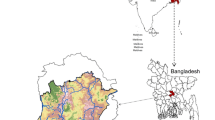Abstract
In urban area, popular and property is accumulated in a small area, potential risk of earthquake disaster in urban community is great. Pre-disaster emergency evacuation zoning has become a significant topic of disaster prevention and mitigation research. Based on the present layout of evacuation facilities and shelters as well as the evacuation demands in urban communities, a systematical methodology for occupant evacuation against earthquakes on community scale was developed by employing spatial analysis techniques of Geographical Information System (GIS). The methodology included the following aspects: the distribution analysis of emergency evacuation demands, the calculation of shelter space accessibility, and the optimization of evacuation destinations. This methodology was applied to Lujiazui Street in Pudong, a new district located in Shanghai, China. It was found that the proposed methodology could be used to formulate pre-event planning for earthquake disaster prevention and mitigation on a community scale, especially for organizing a rapid and smooth evacuation and optimizing the location allocation of shelters.







Similar content being viewed by others
References
Balk DL, Deichmann U, Yetman G (2006) Determining global population distribution: methods, applications and data. Adv Parasitol 62:120–154
Chen G, Tao L, Zhang H (2009) Study on the methodology for evaluating urban and regional disaster carrying capacity and its application. Saf Sci 47(1):50–58
Chin SM, Southworth F (1990) RTMAS: prototype real time traffic monitoring analysis system. Technical manual and user’s manual. Report prepared for the federal emergency management agency, Washington, DC, 20472 (DRAFT)
Deichmann U (1996) A review of spatial population database design and modeling technical report 96-3. National Center for Geographic Information and Analysis, Santa Barbara
Dobson JE, Bright EA, Coleman PR, Durfee RC, Worley BA (2000) LandScan: a global population database for estimating populations at risk. Photogramm Eng Remote Sens 66(7):849–857
Federal Emergency Management Agency (1984) Application of the I-DYNEV system. Five demonstration case studies. FEMA REP-8. Washington, D.C. 20472, 1984
Glickman TS (1986) A methodology for estimating time-of-day variations in the size of a population exposed to risk. Risk Anal 6(3):317–324
Hamza-Lup GL, Hua KA, Le M, Peng R (2004) Enhancing intelligent transportation systems to improve and support homeland security. IEEE intelligent transportation systems conference Washington, D.C., USA. pp 250–255
Huo EJ, Liu CS, Zhang ZQ (2004) The study on the activity of hidden faults in Shanghai. Seismological Press, Bei**g (in Chinese)
Jones PM, Dix MC, Clarke MI, Heggie IG (1983) Understanding travel behavior. Gower Publishing Company, Aldershot, England
Jotshi A, Gong Q, Batta R (2009) Dispatching and routing of emergency vehicles in disaster mitigation using data fusion. Socio-Econ Plan Sci 43(1):1–24
Kitamura R (1988) An evaluation of activity-based travel analysis. Transportation 15:9–34
Li G, Ma DH, Su JY, Wang L (2006) Study on urban earthquake emergency shelters planning. Bei**g University Technol 32(10):901–905 (in Chinese)
Li X, Claramunt C, Kung H-T, Guo Z, Wu J (2008) A decentralized and continuity-based algorithm for delineating capacitated shelters’ service areas. Environ Plan B Plan Des 35(4):593–608
Lu QS, Huang Y, Shekhar S (2003) Evacuation planning: a capacity constrained routing approach. In: Proceeding of the first NSF/NIJ symposium on intelligence and security informatics (ISI 2003)
Pal A, Graettinger AJ, Triche MH (2003) Emergency evacuation modeling based on geographical information system data. TRB 2003 annual meeting CD-ROM
Shi Y, Shi C, Xu SY, Sun AL, Wang J (2010) Exposure assessment of rainstorm waterlogging on old-style residences in Shanghai based on scenario simulation. Nat Hazards 53(2):259–272
Sinuany-Stern Z, Stern E (1990) The role of traffic factors and route choice behavior in simulating urban evacuation. Department of Industrial Engineering and Management, Ben-Gurion University, Beer Sheva, Israel
Southworth F (1991) Regional evacuation modelling: a state-of-the-art review. Oak Ridge National Laboratory, Energy Division, ORNL/TM-11740, Oak Ridge, TN
Su YP (2007) Urban disaster escape and refuges for evacuation. Science Press, China (in Chinese)
Sutton P, Barbara S (1997) Modeling population density with night-time satellite imagery and GIS computers. Environ Urban Syst 21(3/4):227–244
Uno K, Kashiyama K (2008) Development of simulation system for the disaster evacuation based on multi-agent model using GIS. Tsinghua Sci Technol 13:348–353
US Department of Transportation, US Department of Homeland Security (2006). Report to congress on catastrophic hurricane evacuation plan evaluation, 1–189, http://www.fhwa.dot.gov/index.html
Ye MW, Wang J, Liu YL, Xu SY (2008) Study on refuge accessibility of park in inner-city of Shanghai based on GIS technique. Geogr Geo inf Sci 24(2):96–103 (in Chinese)
Zou L, Ren AZ, Zhang X (2006) GIS-based evacuation simulation and rescue dispatch in disaster. Nat Disasters 15(6):1–5
Acknowledgments
This paper was financially supported by the National Natural Science Foundation of China (NSFC) (Project No. 40730526; 41071324), Shanghai Science and Technology Talent Project (Project No. 09QA1401800), the Fundamental Research Funds for the Central Universities, PhD Program Scholarship Fund of ECNU (Project No. 2010033), and Doctor Foundation of Tian** Normal University (No. 52X09019). We gratefully acknowledge the thoughtful comments of the editor and reviewers.
Author information
Authors and Affiliations
Corresponding author
Rights and permissions
About this article
Cite this article
Ye, M., Wang, J., Huang, J. et al. Methodology and its application for community-scale evacuation planning against earthquake disaster. Nat Hazards 61, 881–892 (2012). https://doi.org/10.1007/s11069-011-9803-y
Received:
Accepted:
Published:
Issue Date:
DOI: https://doi.org/10.1007/s11069-011-9803-y




